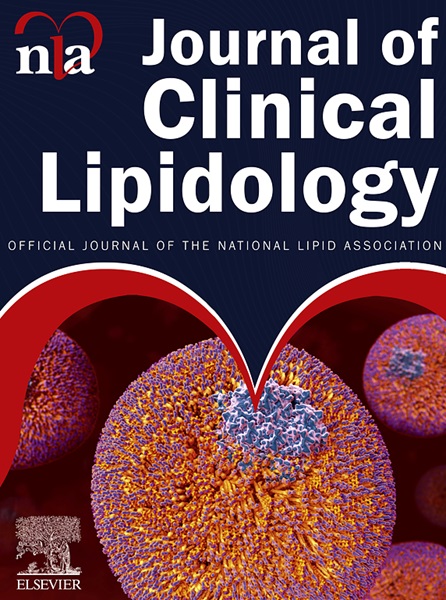Fibrinogen and plasma clot properties are associated with apolipoprotein B and apolipoprotein B-containing lipoproteins in Africans
IF 3.6
3区 医学
Q2 PHARMACOLOGY & PHARMACY
引用次数: 0
Abstract
Case-control, intervention and laboratory studies have demonstrated a link between apolipoprotein B-containing lipoproteins and clot structure and thrombosis. There is, however, limited evidence on population level. We determined the cross-sectional relationship between lipoprotein(a) (Lp(a)), low-density lipoprotein cholesterol (LDL-C), and apolipoprotein B (ApoB) with fibrinogen and plasma clot properties in 1 462 Black South Africans, a population with higher fibrinogen and Lp(a) levels compared with individuals of European descent. Data were obtained from participants in the South African arm of the Prospective Urban and Rural Epidemiology study. Clot properties analysed included lag time, slope, maximum absorbance, and clot lysis time (turbidity). Lp(a) was measured in nM using particle-enhanced immunoturbidimetry. General linear models (GLM) were used to determine the associations between ApoB and ApoB-containing lipoproteins with fibrinogen and plasma clot properties. Stepwise regression was used to determine contributors to clot properties and Lp(a) variance. GLM and regression results combined, indicated fibrinogen concentration and rate of clot formation (slope) had the strongest association with Lp(a); clot density associated positively with both Lp(a) and LDL-C; time to clot formation associated negatively with ApoB; and CLT demonstrated strong positive associations with both ApoB and LDL-C, while its association with Lp(a) was fibrinogen concentration dependent. These findings suggest that ApoB and the lipoproteins carrying it contribute to prothrombotic clot properties in Africans on epidemiological level and highlight potential novel prothrombotic roles for these (apo)lipoproteins to be considered for the development of targeted therapeutic approaches to address thrombotic conditions related to clot properties.非洲人的纤维蛋白原和血浆凝块特性与载脂蛋白 B 和含载脂蛋白 B 的脂蛋白有关
病例对照研究、干预研究和实验室研究表明,含脂蛋白 B 的脂蛋白与血栓结构和血栓形成之间存在联系。然而,人群层面的证据却很有限。我们确定了 1462 名南非黑人中脂蛋白(a)(Lp(a))、低密度脂蛋白胆固醇(LDL-C)和载脂蛋白 B(ApoB)与纤维蛋白原和血浆凝块特性之间的横断面关系,与欧洲后裔相比,南非黑人的纤维蛋白原和 Lp(a)水平较高。数据来自前瞻性城乡流行病学研究南非分部的参与者。分析的凝块特性包括滞后时间、斜率、最大吸光度和凝块溶解时间(浊度)。使用颗粒增强免疫比浊法测量脂蛋白(a),单位为 nM。一般线性模型(GLM)用于确定载脂蛋白和含载脂蛋白脂蛋白与纤维蛋白原和血浆凝块特性之间的关系。逐步回归法用于确定凝块特性和脂蛋白(a)变异的贡献因素。GLM 和回归结果表明,纤维蛋白原浓度和血凝块形成率(斜率)与脂蛋白(a)的关系最为密切;血凝块密度与脂蛋白(a)和低密度脂蛋白胆固醇均呈正相关;血凝块形成时间与载脂蛋白B呈负相关;CLT 与载脂蛋白B 和低密度脂蛋白胆固醇均呈正相关,而其与脂蛋白(a)的关系取决于纤维蛋白原浓度。这些研究结果表明,载脂蛋白B和携带载脂蛋白的脂蛋白在流行病学水平上导致了非洲人血栓形成的凝块特性,并强调了这些(载脂蛋白)脂蛋白潜在的新的促血栓形成作用,以便考虑开发有针对性的治疗方法,解决与凝块特性有关的血栓问题。
本文章由计算机程序翻译,如有差异,请以英文原文为准。
求助全文
约1分钟内获得全文
求助全文
来源期刊
CiteScore
7.00
自引率
6.80%
发文量
209
审稿时长
49 days
期刊介绍:
Because the scope of clinical lipidology is broad, the topics addressed by the Journal are equally diverse. Typical articles explore lipidology as it is practiced in the treatment setting, recent developments in pharmacological research, reports of treatment and trials, case studies, the impact of lifestyle modification, and similar academic material of interest to the practitioner. While preference is given to material of immediate practical concern, the science that underpins lipidology is forwarded by expert contributors so that evidence-based approaches to reducing cardiovascular and coronary heart disease can be made immediately available to our readers. Sections of the Journal will address pioneering studies and the clinicians who conduct them, case studies, ethical standards and conduct, professional guidance such as ATP and NCEP, editorial commentary, letters from readers, National Lipid Association (NLA) news and upcoming event information, as well as abstracts from the NLA annual scientific sessions and the scientific forums held by its chapters, when appropriate.

 求助内容:
求助内容: 应助结果提醒方式:
应助结果提醒方式:


